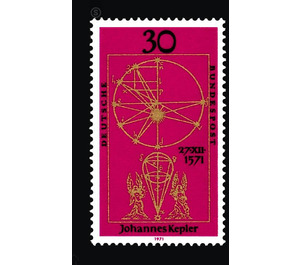400th birthday of Johannes Kepler - Germany / Federal Republic of Germany 1971 - 30 Pfennig
Theme: Calender
| Country | Germany / Federal Republic of Germany |
| Issue Date | 1971 |
| Face Value | 30.00 |
| Color | red |
| Perforation | K 14 |
| Printing Type | Multi-color rotogravure printing |
| Stamp Type | Postage stamp |
| Item Type | Stamp |
| Chronological Issue Number | 577 |
| Chronological Chapter | GER-BRD |
| SID | 692121 |
| In 44 Wishlists | |
Johannes Kepler, born 1571 in the free imperial city of Wyl, today Weil der Stadt, died in Regensburg in 1630, worked in Graz, Prague, Linz, Ulm and Sagan. He is one of the founders of the new natural science. The development of the three "Kepler Planetary Laws" is well known as his peculiar achievement, the basis for his famous Rudolphine tables, and others. a. to calculate the planetary positions in past and future. But its meaning for astronomy and physics is much more general. He looked at the order of planetary motion as a consequence of a force emanating from the sun, the foundation of the dynamics of the sky; he attributed a mutual attraction to all matter, thus explaining for the first time the appearance of ebb and flow as a result of the power of the moon on the earth and the falling of the stone on the earth as a result of the force acting between earth and stone. At the end of the 17th century, these Keplerian "principles" joined Newton in the theory of gravitation. His optical works come to this "physics of the sky"; the terms focus and dioptrics are from Kepler. Among the numerous results are the first correct theory of seeing, the theory of the spectacles, the first attempt to explain the rainbow, the sky blue and the comet's tail, and the doctrine of lens and mirror imaging, which makes it the invention of the astronomical and terrestrial Keplerian Telescope «led. Among the works left behind - 15 large and 21 smaller books, plus a few hundred letters - is the "world harmony" of 1619 of a special kind: a first attempt, all being - from music to the solar system - due to excellent mathematical relations. Meaningful and noteworthy is Kepler's ethical justification of natural research. Throughout his life, he stood up for peace and the end of denominational conflict. The largest part of the manuscript estate was acquired by Catherine of Russia in 1773 and is kept in Leningrad. The publication and scientific history of the Keplerwerke is in the hands of the Bavarian Academy of Sciences. In the birthplace in Weil der Stadt, the Kepler Society maintains a Kepler museum, a second is in the death home in Regensburg.


